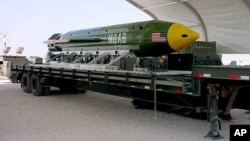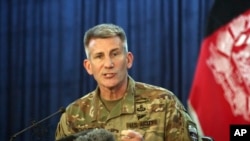President Donald Trump praised the U.S. military for successfully blasting an Islamic State stronghold in Afghanistan’s Nangarhar province with a Massive Ordinance Air Bomb (MOAB), the biggest non-nuclear explosive in the American arsenal.
“It was another successful event,” Trump told reporters at the White House. “If you look at what’s happened over the last eight weeks and compare that really to what’s happened over the past eight years, you’ll see there’s a tremendous difference, tremendous difference.”
The Islamic State group has made inroads in Afghanistan in recent years and has claimed responsibility for deadly attacks, including last month’s assault on a military hospital in Kabul that killed more than 30 people and injured 80 others.
But compared with Iraq and Syria, where the IS extremists first became notorious in 2014, the group’s branch in Afghanistan is not as potent. That raises some questions about why Afghanistan was chosen for the first use of the 10,000-kilogram MOAB, known informally as “the mother of all bombs.”
Explainer: MOAB bomb
No civilians where bomb fell
Rebecca Zimmerman, a policy researcher for the Rand Corp., thinks eastern Afghanistan was chosen for the first use of the bomb Thursday for what may seem like a counterintuitive reason: to avoid civilian casualties, because the target was in such a remote place.
“It is impossible to use a weapon like this in Syria, Iraq and most other places, because they are heavily populated, and Afghanistan less so,” Zimmerman said.
The MOAB device was not merely a bomb, in this case, Zimmerman added. It carried a message that was heard well beyond its blast zone, and “sends a signal to Islamic State globally that the U.S is resolved and is willing to employ some fairly extreme measures in order to succeed” in the fight against terrorists.
Lawrence Korb, a former assistant secretary of defense in Washington and currently a senior fellow at the Center for American Progress, agrees that the bomb was a message for Islamic State, but he also notes that the bunker and tunnel complex the U.S. forces were targeting required the use of the huge bomb, which detonates above the surface and creates a shock wave that destroys everything and kills anyone in its path over a wide area.
Islamic State fighters in Afghanistan, “in the area where they are along the Pakistani border, have dug a lot of tunnels, and there was no way that traditional bombs would be able to impact them,” Korb said.
Illustrating U.S. military might
Other analysts suggest that the MOAB device was employed on the IS hideout because that target was a perfect opportunity to demonstrate overwhelming U.S. military might.
“The area was what they call a civilian-free zone, so they could really go in and use a big, indiscriminate weapon, which, God forbid, if you dropped it in a place like Raqqa [Islamic State’s headquarters in Syria], you would have lots of civilian deaths,” said Brian G. Williams, author of Counter Jihad: America’s Military Experience in Afghanistan, Iraq and Syria.
“This is a unique enemy position” in Nangarhar province, Williams said. “It is entrenched and away from civilians. The attack killed around 36 IS fighters, according to the Afghan government; it was a perfect opportunity for demonstration of might.”
Thomas Johnson, director of the Naval Postgraduate School’s program for cultural and conflict studies, believes MOAB will not have a major impact on IS.
“I think this will have minimum impact on IS-Khorasan,” Johnson said, using the title that distinguishes Islamic State in Afghanistan from the branches of the group in Iraq and Syria.
“The attack yesterday was more symbolic,” Johnson added, “and actually had more domestic political implications [in the U.S.] than implications in Afghanistan.”
Taliban switched sides to IS
While Islamic State’s ranks in Afghanistan do include foreign fighters, Johnson said most of the extremist group’s recruits are former Taliban members who joined for financial reasons.
“Many Taliban foot soldiers joined IS because it was offering $700 a month, which was a lot more money than the Taliban could offer,” Johnson said. When the United States and its coalition allies destroyed Islamic State’s financial networks in Syria and elsewhere, he added, IS recruits, including those from the Taliban, began to drift away.
Compared with Afghanistan and other parts of South Asia, Johnson added, the West should devote more attention to combating Islamic State in Central Asia, where the group has been attracting sympathizers.
Bill Goodfellow, executive director of the Center for International Policy, argues that the fight against IS in Afghanistan should not come at the expense of ignoring the Taliban.
“I do not think that this massive bomb is going to change the dynamics at all,” Goodfellow said.
Islamic State “does complicate things” in Afghanistan, he added, because they represent another violent extremist group operating in the country, “and they seem to be rather hardened and many of them are foreigners.” Goodfellow's CIP group is a nonprofit research and advocacy group based in Washington that tries to promote cooperation, transparency and accountability in global relations.
“Ultimately the deal has to be made between the Taliban and the Afghan government and civil society, and it has to be some sort of enduring peace, and the regional powers, particularly Pakistan, have to be brought in,” Goodfellow said. “That’s where we should be focusing our attention.”
A tactical military decision?
Hamdullah Mohib, Afghanistan’s ambassador to the United States, told VOA that the Afghan national security forces, backed by NATO, had been conducting military operations in eastern Nangarhar against IS forces for a week before Thursday’s bombing, and that improvised explosive devices (IEDs) planted by extremist fighters had made it difficult to advance.
General John Nicholson, the top U.S. military commander in Afghanistan, echoed the ambassador’s comments about IEDs while talking to reporters in Kabul Friday. He said his decision to use MOAB was communicated with officials in Washington and was a purely tactical decision.
“This was the right weapon for the right target,” Nicholson said. “This is the right munition to reduce these obstacles and maintain the momentum of our offensive.”
The office of Afghan President Ashraf Ghani said the operation was not a surprise, and that it had been closely coordinated with the Afghan security forces.
Reaction to the bombing from civilians in the area has been mixed.
Residents of Achin district, where the IS hideout was located, posted a video from the scene praising the decision.
“There were ISIS fighters here,” a local resident said, pointing to the area in the background where the big bomb exploded. “I am very happy that they destroyed IS here. There are no civilians here.”
Others in the area who opposed the use of the huge bomb said they were concerned that Afghanistan could become a weapons testing ground.











